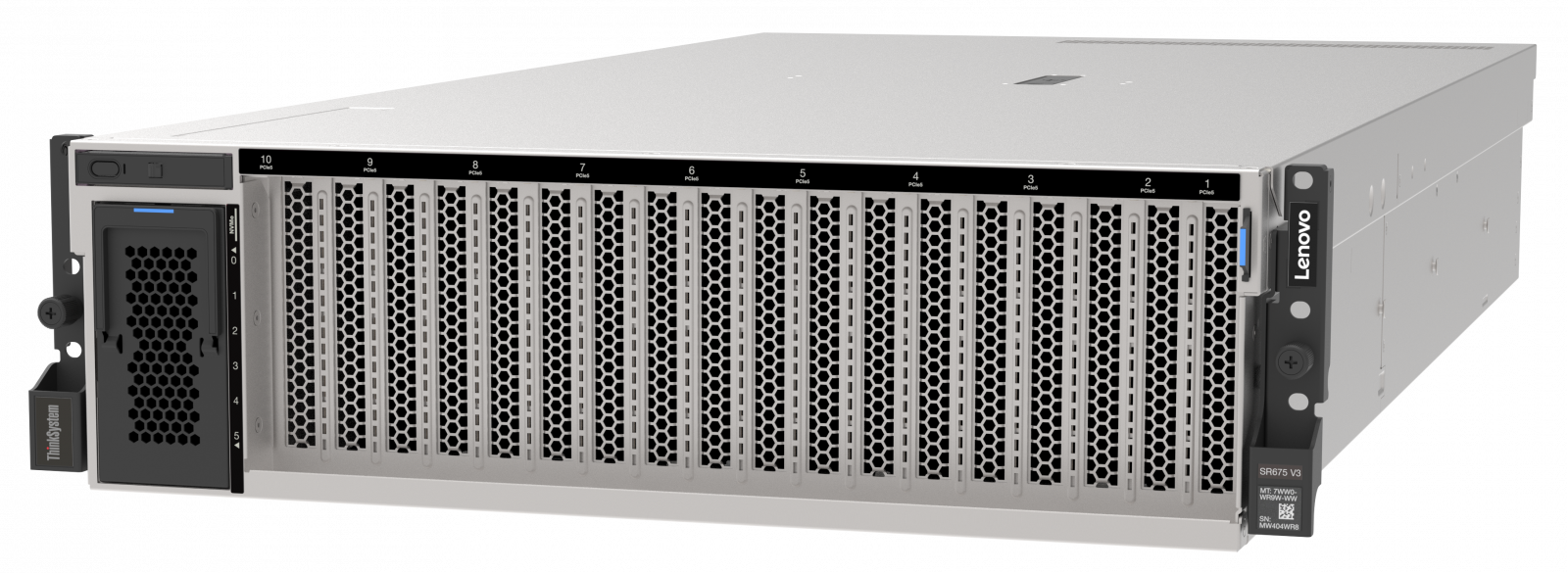Author
Published
1 May 2024Form Number
LP1915PDF size
5 pages, 1017 KBAbstract
In the rapidly evolving realm of artificial intelligence and machine learning, the Lenovo ThinkSystem SR675 V3 server has proven its mettle by undergoing comprehensive testing using the MLPerf benchmark suite. This article explores the technical aspects and industry applications of the SR675 V3 server's performance based on the MLPerf results.
Introduction
MLPerf benchmarks are the gold standard for evaluating the performance of machine learning models across diverse tasks. The Lenovo ThinkSystem SR675 V3 server, equipped with cutting-edge hardware, has been put through rigorous testing across various ML workloads, showcasing exceptional results that highlight its efficiency and capabilities.

Figure 1. Lenovo ThinkSystem SR675 V3 configured with 8x 80GB PCIe H100 GPUs
Technical breakdown of MLPerf results
The results across different workloads on the SR675 V3 server and its configuration with 4x 96GB SXM5 H100 (AMD EPYC 9654 96-Core) and 8x 80GB PCIe H100 (AMD EPYC 9554 64-Core) to certify their performance.
These results showcase the significant performance gains observed when utilizing 4x 80GB SXM5 H100 GPUs and the AMD EPYC 9654 96-Core processors, emphasizing the server's scalability and enhanced processing capabilities across various tasks.
Industry applications of SR675 V3's performance
The improved performance across these workloads has a myriad of real-world applications in diverse industries:
- NLP in Customer Service and Financial Sectors
Faster BERT inference speeds enable real-time sentiment analysis and document summarization for enhanced customer experiences and streamlined financial analyses.
- Computer Vision in Retail and Manufacturing
Quicker Mask RCNN and ResNet50 inference times facilitate faster object detection, aiding inventory management, defect detection, and quality control in manufacturing and retail.
- Autonomous Vehicles and Surveillance
SSD workload enhancements support faster object detection, crucial for real-time decision-making in traffic control and surveillance applications.
- Speech Recognition in Healthcare and Telecommunications
Improved RNNT performance can revolutionize speech recognition applications, benefiting healthcare transcription and voice-activated systems in telecommunications.
- Healthcare Imaging and Research
Speedier 3D-UNet inference can advance medical imaging for disease diagnosis, drug discovery, and treatment planning, potentially saving lives through timely diagnoses.
Conclusion
The MLPerf results for the SR675 V3 server and its performance with 80GB SXM5 H100 (AMD EPYC 9654 96-Core) unveil not only its technical capabilities but also its potential to drive innovation and efficiency across multiple industries. The SR675 V3 stands as a beacon of high-performance computing solutions, promising to power transformative applications and services in AI and machine learning.
From healthcare to retail, finance to autonomous systems, the SR675 V3 server's exceptional performance across various ML workloads underscores its significance in shaping the future of AI-driven applications. As organizations seek advanced technologies, the SR675 V3 server proves to be a leading solution in driving this technological evolution.
For more information
For more information, see the following resources:
- Explore Lenovo AI solutions:
https://www.lenovo.com/us/en/servers-storage/solutions/analytics-ai/ - Engage the Lenovo AI Center of Excellence:
https://lenovoaicodelab.atlassian.net/servicedesk/customer/portal/3
MLCommons®, the open engineering consortium and leading force behind MLPerf, has now released new results for MLPerf benchmark suites:
- Benchmark results: https://mlcommons.org/en/training-normal-20/
- Latest news about MLCommons: https://mlcommons.org/news-blog
Author
Carlos Huescas is the Worldwide Product Manager for NVIDIA software at Lenovo. He specializes in High Performance Computing and AI solutions. He has more than 15 years of experience as an IT architect and in product management positions across several high-tech companies.
Trademarks
Lenovo and the Lenovo logo are trademarks or registered trademarks of Lenovo in the United States, other countries, or both. A current list of Lenovo trademarks is available on the Web at https://www.lenovo.com/us/en/legal/copytrade/.
The following terms are trademarks of Lenovo in the United States, other countries, or both:
Lenovo®
ThinkSystem®
The following terms are trademarks of other companies:
AMD and AMD EPYC™ are trademarks of Advanced Micro Devices, Inc.
Other company, product, or service names may be trademarks or service marks of others.
Configure and Buy
Full Change History
Course Detail
Employees Only Content
The content in this document with a is only visible to employees who are logged in. Logon using your Lenovo ITcode and password via Lenovo single-signon (SSO).
The author of the document has determined that this content is classified as Lenovo Internal and should not be normally be made available to people who are not employees or contractors. This includes partners, customers, and competitors. The reasons may vary and you should reach out to the authors of the document for clarification, if needed. Be cautious about sharing this content with others as it may contain sensitive information.
Any visitor to the Lenovo Press web site who is not logged on will not be able to see this employee-only content. This content is excluded from search engine indexes and will not appear in any search results.
For all users, including logged-in employees, this employee-only content does not appear in the PDF version of this document.
This functionality is cookie based. The web site will normally remember your login state between browser sessions, however, if you clear cookies at the end of a session or work in an Incognito/Private browser window, then you will need to log in each time.
If you have any questions about this feature of the Lenovo Press web, please email David Watts at dwatts@lenovo.com.
